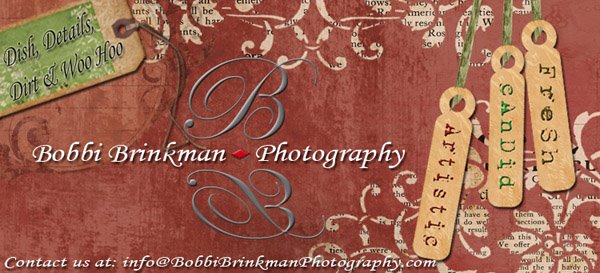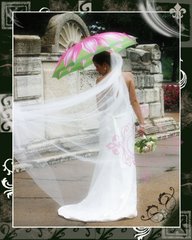 As I'm sure you know, weddings are full of significance from old traditions to new ideas, from superstitions passed down through the ages to old wives tales. Presented below are a few things you might not know the origins of some interesting tradition and lore:
As I'm sure you know, weddings are full of significance from old traditions to new ideas, from superstitions passed down through the ages to old wives tales. Presented below are a few things you might not know the origins of some interesting tradition and lore:Generations ago, that very loooooooooooooooooooong walk down the aisle was meant to show transfer of ownership--- from the father to the husband. This walk transferred the ownership of his daughter and dowry. The bridal walk 'sealed the deal' between families.
Before the best man and maid of honor sign a legally binding document that upholds a wedding, witnesses were the only way that the married couple had to show that they were indeed wed.
Families sit today on the 'brides side' or the 'grooms side'. This tradition comes from needful separation of the two families and any fights that might come about. Think the Hatfields and McCoys!
Traditionally the bride stands on the left of the groom during the ceremony. This tradition developed during medieval times when men carried swords. If the bride stood on the right side she would have blocked his sword making it impossible for him to protect her, so the bride stands to the left and has ever since. During this time the term best man was also created. Typically the best man at the wedding was the best swordsman also.
Why are there bridesmaids? Today many people choose to have bridesmaids because of tradition, and for fun. Since the middle ages bridesmaids have been responsible for helping with the preparation of the wedding. In the beginning bridesmaids were simply hired or slave help, and they did not walk the aisle.
During the formation of our country bridesmaids used to dress exactly like the bride because of spiritual superstition. People believed if they all dressed exactly like the bride evil spirits wouldn't know which girl was being married and couldn't harm her. Today bridesmaid dresses vary in style from the bride's gown.
There are many spiritual superstitions surrounding weddings. The bridal bouquet was at first a satchel of herbs meant to protect the bride from evil spirits. Only later did the satchel become a bouquet of flowers.
There are many spiritual superstitions surrounding weddings. The bridal bouquet was at first a satchel of herbs meant to protect the bride from evil spirits. Only later did the satchel become a bouquet of flowers.
Toasts at the reception? Long ago, the clinking of glasses during the reception was also believed to keep evil spirits from harming the new marriage; it was believed the spirits didn't like boisterous noise. Rather like todays tradition in many Asian cultures when firecrackers are set off after a wedding---- the noise is believed to run off evil spirits.
Apart from evil superstition people also believed that weddings were symbols of good luck. This is how the tradition of the garter toss and bridal bouquet toss were developed. People believed to take something of the brides would bring good luck.
Apart from evil superstition people also believed that weddings were symbols of good luck. This is how the tradition of the garter toss and bridal bouquet toss were developed. People believed to take something of the brides would bring good luck.
Hopes of fertility also surrounded weddings for a very long time. The guests at a wedding believed the bride would become pregnant soon after the wedding if she were the first to eat the cake. Throwing rice after the ceremony was also meant to signify fertility in the hopes the new couple would have many children. For those career couples---- don't eat the cake or have rice thrown! :)
Contrary to popular thought, brides today wear white because of fashion. Prior to 1840 when Queen Victoria wore white lace to her wedding, brides wore their best dress. Wedding dresses at this time were many colors.
Contrary to popular thought, brides today wear white because of fashion. Prior to 1840 when Queen Victoria wore white lace to her wedding, brides wore their best dress. Wedding dresses at this time were many colors.
The veil, meant to symbolize purity came from a tradition where the groom kidnapped the bride. If a man could get a girl away from her family long enough they were basically married. When the brides were kidnapped their faces were covered with a white cloth which has now become a veil.
The kiss at the end of the ceremony symbolizes the binding union that the husband and wife have to each other. Some people believed when the bride and groom kissed for the first time they shared a part of their soul.
The kiss at the end of the ceremony symbolizes the binding union that the husband and wife have to each other. Some people believed when the bride and groom kissed for the first time they shared a part of their soul.
The ring, meant to symbolize the bond of marriage is worn on the fourth finger of the left hand because it was believed there was a vein that in that finger that ran to the heart. The first wedding bands were made of grass and hay. Today traditional wedding bands are made of gold. (Or platinum if you are very lucky!) During World War II men in the United States began to wear wedding bands because they wanted a way to remember their wives while at war. Today both the husband and wife wear wedding bands.
Over the years the beginnings of most of these wedding traditions have been forgotten. Today weddings are about love and family. Although the traditions hold different meanings today they are still as important as they were hundreds of years ago.
-Rachel Pickett
Over the years the beginnings of most of these wedding traditions have been forgotten. Today weddings are about love and family. Although the traditions hold different meanings today they are still as important as they were hundreds of years ago.
-Rachel Pickett











No comments:
Post a Comment